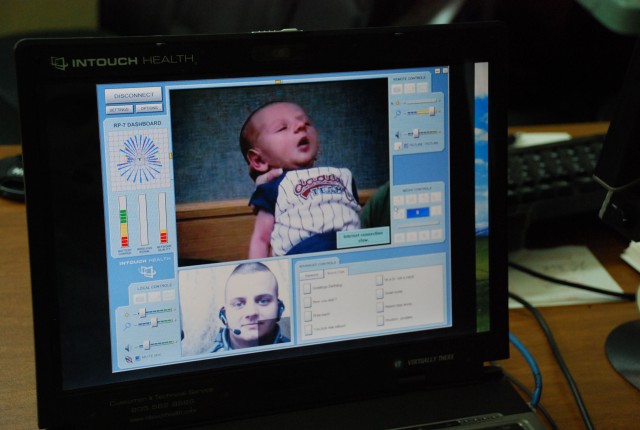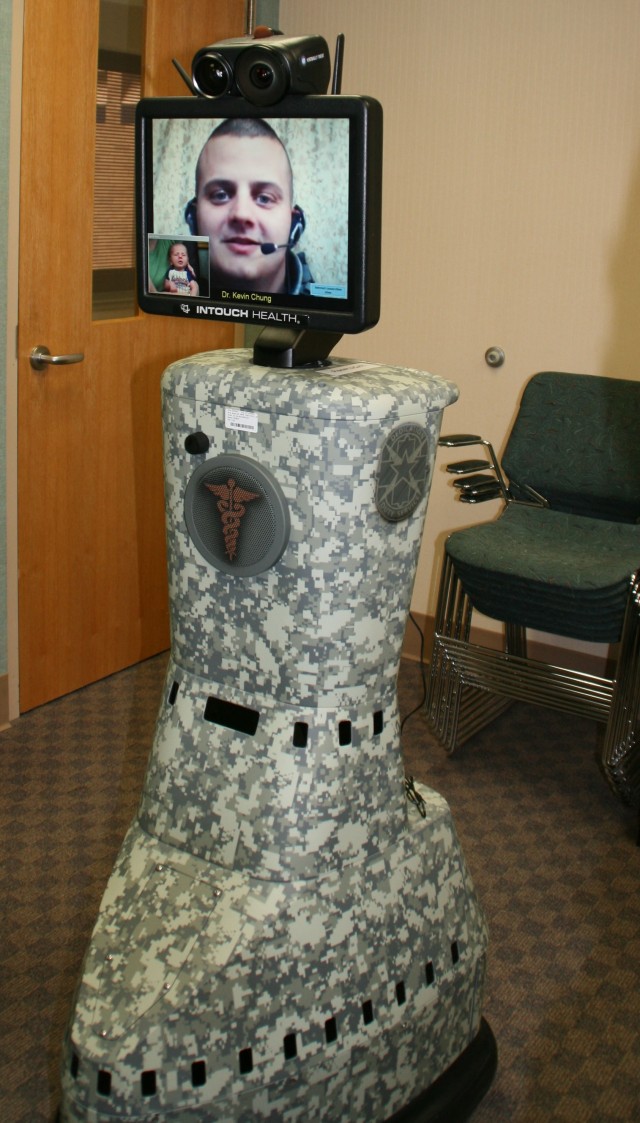FORT SAM HOUSTON, Texas -- One of the most touching moments in a new Family\'s life is when a father and mother meet their newborn child seconds after birth.
In times of war throughout the centuries, fathers have missed the blessed event because they were away serving their country. Pictures may say a thousand words, but they don't begin to convey what real-time viewing can accomplish.
One fortunate daddy away in Baghdad had the opportunity to see his son for the first time in real time April 10 with the use of an RP-7 Remote Presence Robotic System and a computer link.
Once the stuff of science fiction literature and fantasy films, robots are playing an important role in health care and, in the case of the Lloyds, keeping Families in touch.
Staff Sgt. Erik Lloyd, assigned to the United States Army Institute of Surgical Research and currently serving with the Deployed Combat Casualty Research Team collocated with the 86th Combat Support Hospital unit in Baghdad, missed the birth of his first child, a son, born April 4 at 2:20 a.m., weighing in at 7 pounds, 4 ounces.
Gathered in conference room 313-11 at Brooke Army Medical Center, "Chungbot," as the RP-7 is fondly referred, and the staff of the lab research program at USAISR assembled for a real-time introduction of Lloyd and new baby boy, Blake.
"So, who do we have here'" said Lloyd from Baghdad, panning the monitor of the robot around to see everyone gathered around the 5 and a half-foot tall "Chungbot."
As the monitor swiveled around, controlled by the use of a joy stick connected to a laptop in Baghdad, Lloyd focused in on his son for the first time, live. "Hey! Is he asleep' Poke him to wake him up. Hold his head so we can get a picture from our end," said Lloyd playing with the controls and making the most of the robot's capabilities.
Between the ooohs and the aaahs over the 2-week-old infant, Lloyd kept a grin on his face and eyes on his son. During casual chit-chat between the group in the room and his wife Kristie, Lloyd asked questions about his son and played with the controls of the robot.
"He'll be walking and potty trained by the time I get back, right'" joked Lloyd, who is due to return home in six months.
"Lloyd was amazed at the technology and the clarity of the video link. The interaction they had was amplified by his ability to move the robot around and zoom in and out with the camera. He was able to see his son close up. Granted nothing is better than being there in person, but given the circumstances with him being half a world away, this technology allowed him to be 'remotely' present with his newly expanded family," said Maj. Kevin Chung, medical director for the USAISR's burn intensive care unit at BAMC. "The entire session was very emotional for all those who had the opportunity to witness the remote interaction."
"It was an awesome experience. I am far from the first father in this conflict who has missed the birth of their child. Blake is my first child; however, with this technology I was in a small way allowed to feel more like I was part of a "Family" than I had been for the past few weeks since he was born," said Lloyd.
"I talk to him (Erik) everyday and he demands pictures all the time. We use a Webcam but the connection isn't good," said Kristie Lloyd. "But this was great. Erik was playing with the controls and trying to figure out how to use the robot." "
Many of us have left children behind to serve our country overseas. Often the only way we get to interact or even see our Families is through pictures, e-mails or letters. It was such a wonderful experience to be able to actively interact with my wife while she was able to show me our son for the first time. I was able to control the robot and actually move around the room a bit to get a different perspective than what a conventional video camera would have allowed," added the new father.
RP-7 is a wireless, mobile, Remote Presence Robot that allows a doctor to "be in two places at once." Under the direct control of a remote physician seated at a Control Station, RP-7 can move untethered allowing the physician to freely interact with patients, Family members and hospital staff from anywhere, anytime.
Chung is accustomed to people addressing his image on an RP-07 robotic system while he is sitting at a keyboard in another location. He uses it from home, while on leave, temporary duty assignments, or while at conferences from outside of the state in order to have access to the ICU. When outside the ICU, Chung is available to the ICU via the robot.
The advanced digital camera can be panned, tilted or zoomed. The camera's resolution allows a physician at the control station to read monitor screens or printouts.
"I am very appreciative of the command groups, both here at the 86th CSH and the Institute of Surgical Research, for allowing me to utilize this amazing piece of technology. It is really a wonderful feeling to be part of two commands that know how to take care of their Soldiers and their Families in a time of need." said Lloyd.




Social Sharing